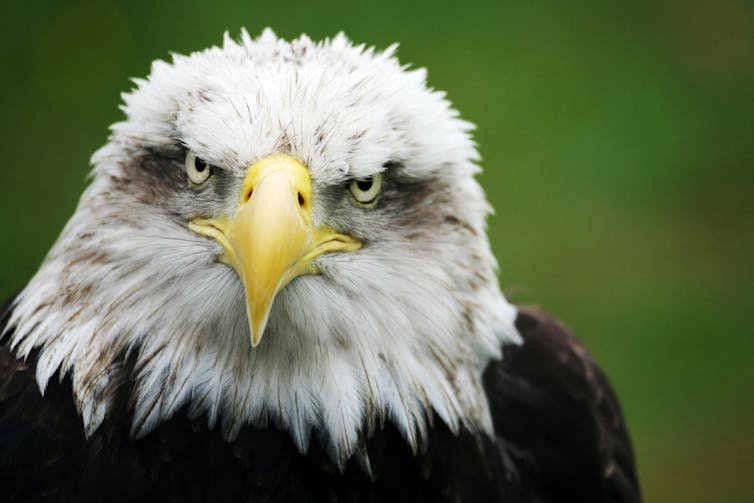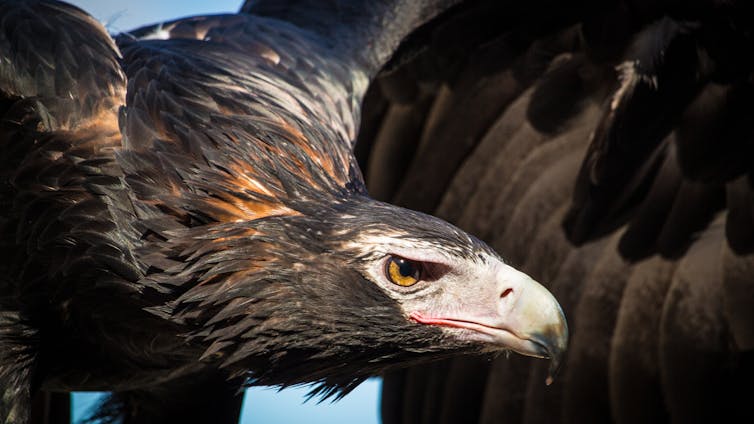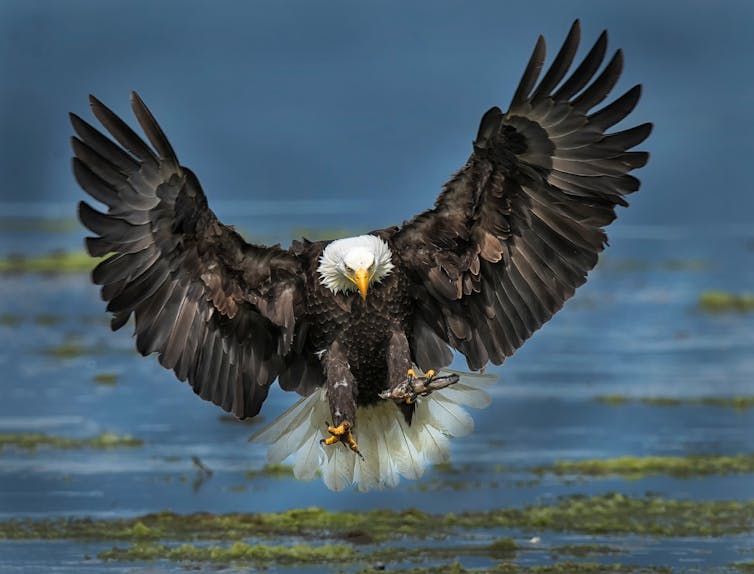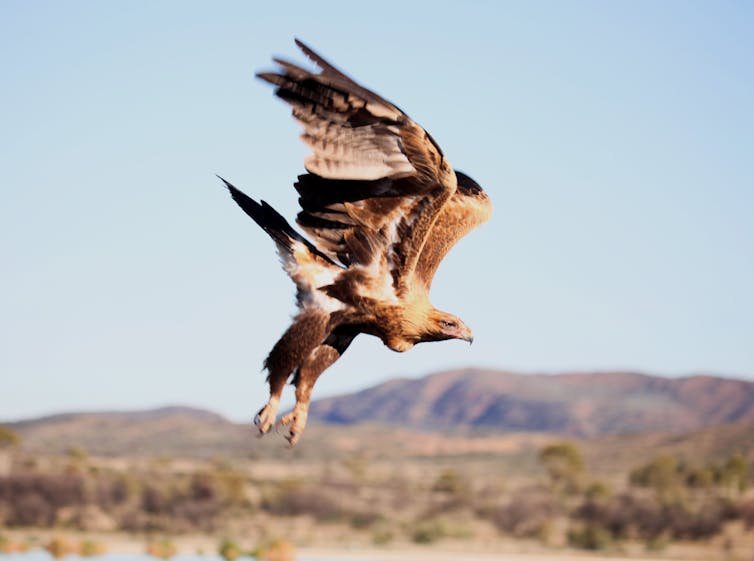Who would win in a fight between a wedge-tailed eagle and a bald eagle? It's a close call for two nationally revered birds
- Written by Dominique Potvin, Senior Lecturer in Animal Ecology, University of the Sunshine Coast
This article is part of the “Who would win?[1]” series, where wildlife experts dream up hypothetical battles between predators (all in the name of science).
America’s most-loved bird versus a scrappy Aussie scavenger. In a clash that might rival Crocodile Dundee in New York City, here we’ll pit two iconic birds of prey against one another: the wedge-tailed eagle and the North American bald eagle.
As a disclaimer, this exercise is well and truly hypothetical. Wedge-tailed eagles[2] are native to Australia and would never encounter a bald eagle, which has a range covering most of North America, in the wild.
This is probably why they can both exist in the healthy numbers on both continents: their similar niches would likely result in high levels of competition for resources such as food and nesting sites, especially sites close to the ocean.
In fact, wedgies, Australia’s largest raptor, have such few competitors, they’ve actually taken on the role played by vultures and condors in the rest of the world: that of scavenger. While bald eagles[3] will also scavenge large prey, their speciality is fish.
So before we get into the details of the fight (and, potentially, a diplomatic incident), let’s learn more about these two enormous birds of prey.
 The bald eagle is the national emblem for the US.
Alvaro Postigo/Unsplash
The bald eagle is the national emblem for the US.
Alvaro Postigo/Unsplash
Their fan base
Both species are thankfully doing well in terms of numbers, which is great news for humans because they play important roles. They clean up carrion and keep numbers of rapidly reproducing small mammals in check — think rabbits, mice, rats.
Read more: Who would win in a fight between an octopus and a seabird? Two marine biologists place their bets[4]
They are both also very important in the culture of Indigenous people on both continents. In Australia, many Aboriginal Dreaming stories include the wedge-tailed eagle, especially in depictions of Bunjil the creator, and some have even associated constellations with it[5]. In native North American cultures, bald eagle feathers are highly esteemed[6], symbolising bravery, strength and holiness.
 Wedge-tailed eagles are scavengers, and are often seen feasting on road kill.
Shutterstock
Wedge-tailed eagles are scavengers, and are often seen feasting on road kill.
Shutterstock
The birds’ sheer size means they are easily recognised in their native ranges, making them apt emblems.

Of course, the bald eagle has the honour of being the United States’ national bird[7], appearing on its coat of arms. The wedge-tailed eagle is an emblem in the Northern Territory, and appears on the Royal Australian Air Force badge[8].
Each country also has one professional football team named after the respective birds: The Philadelphia Eagles in the US, and the West Coast Eagles in Australia’s AFL.
So despite historical conflict[9] with humans blaming the birds[10] for losses to livestock, they both have a pretty strong fan base today.
While both eagles are part of the same family group (Accipitridae), they are not very closely related, belonging to different genera.

The wedge-tailed eagle (Aquila audax) fits in a group sometimes referred to as “true eagles”, which also holds some of the most widespread eagles in the world, such as the golden eagle (Aquila chrysaetos).
Bald eagles (Haliaeetus leucocephalus), on the other hand, belong in the Haliaeetus genus, a group of predominantly fish-eating birds of prey that includes Australia’s own white-bellied sea eagle (Haliaeetus leucogaster).
Thus, it may seem like the odds are already stacked: what chance would a bird that eats fish as its main meal have against a bird that eats just about anything – alive or dead?
 Bald eagles predominately prey on fish.
Shutterstock
Bald eagles predominately prey on fish.
Shutterstock
A close match
Well, they are in fact well matched in terms of potential fighting ability.
Both average about four to five kilograms, with almost identical wingspans of between 1.8 and 2.3 metres. Both have large, curved, strong beaks for tearing meat off the bones of their prey.
What opponents need to most be wary of, however, are the legs and talons.
Both species have strong feet with which to grab prey of the ground (or water) and carry it away to eat in peace. Neither have natural predators. It would indeed be a close match.
 AFL/NFL official logos
So, let’s say — hypothetically of course — that a wedge-tailed eagle and a bald eagle are in the same place at the same time, vying for the same prey.
It’s likely the bald eagle would be perched on a nearby clifftop, and the wedgie would be circling in the skies, high above. A poor, unassuming rodent (perhaps of unusual size, making it highly prized) is minding its own business on the ground below.
Both predators see the rodent as well as each other with their excellent vision — eagles generally have the best eyesight of all known vertebrates. A speedy downwards dive by both, up to 160 kilometres per hour, would signal the fight has commenced.
Before hitting the ground, the rodent, or each other, they’d flap their wings to slow down, revealing their legs and talons. These would reach out towards the opponent and, depending on where each bird grabs, might signify the end for the other. It would likely be quite the grapple and possibly even a trial of endurance.
AFL/NFL official logos
So, let’s say — hypothetically of course — that a wedge-tailed eagle and a bald eagle are in the same place at the same time, vying for the same prey.
It’s likely the bald eagle would be perched on a nearby clifftop, and the wedgie would be circling in the skies, high above. A poor, unassuming rodent (perhaps of unusual size, making it highly prized) is minding its own business on the ground below.
Both predators see the rodent as well as each other with their excellent vision — eagles generally have the best eyesight of all known vertebrates. A speedy downwards dive by both, up to 160 kilometres per hour, would signal the fight has commenced.
Before hitting the ground, the rodent, or each other, they’d flap their wings to slow down, revealing their legs and talons. These would reach out towards the opponent and, depending on where each bird grabs, might signify the end for the other. It would likely be quite the grapple and possibly even a trial of endurance.
 Wedge-tailed eagles have a wingspan of over two metres.
Shutterstock
The verdict?
My money, however, is on the wedge-tailed eagle.
While wedge-tailed eagles are a similar size to bald eagles, they’re able to kill slightly bigger prey. Bald eagles tend to feed on fish and small mammals (as well as reptiles, and carrion to an extent), but they rarely target anything bigger than, say, a racoon or beaver.
While wedge-tails regularly eat similarly sized mammals such as rabbits, they will also attack[11] kangaroos, koalas and even goannas.
This might make them more accustomed to targeting diverse, large prey.
Bald eagle vs Donald Trump.But the real tests that clinch my decision are odd encounters these birds face in the real world.
Recently, numbers of bald eagles have increased such that their range now overlaps with the common loon in North America, a diving waterbird with a sharp beak. And it appears that loons are able to stab bald eagles[12] trying to obtain their young as prey, killing them. Canada 1: USA 0.
Not a great look for the majestic baldie.
Compare this to the wedge-tailed eagle, which is the only bird in the world known to actively attack[13] paragliders and hang gliders , as well as drones[14]. They do this because they likely see them as threats, and are attempting to defend their territory.
Therefore, in terms of motivation and sheer boldness when taking on an opponent, my bets are placed firmly in the talons of the wedgie.
Who would win in a fight between a scorpion and a tarantula?
Read more:
Who would win in a fight between an emu and a cassowary? One has a dagger-like claw, the other explosive agility[15]
Wedge-tailed eagles have a wingspan of over two metres.
Shutterstock
The verdict?
My money, however, is on the wedge-tailed eagle.
While wedge-tailed eagles are a similar size to bald eagles, they’re able to kill slightly bigger prey. Bald eagles tend to feed on fish and small mammals (as well as reptiles, and carrion to an extent), but they rarely target anything bigger than, say, a racoon or beaver.
While wedge-tails regularly eat similarly sized mammals such as rabbits, they will also attack[11] kangaroos, koalas and even goannas.
This might make them more accustomed to targeting diverse, large prey.
Bald eagle vs Donald Trump.But the real tests that clinch my decision are odd encounters these birds face in the real world.
Recently, numbers of bald eagles have increased such that their range now overlaps with the common loon in North America, a diving waterbird with a sharp beak. And it appears that loons are able to stab bald eagles[12] trying to obtain their young as prey, killing them. Canada 1: USA 0.
Not a great look for the majestic baldie.
Compare this to the wedge-tailed eagle, which is the only bird in the world known to actively attack[13] paragliders and hang gliders , as well as drones[14]. They do this because they likely see them as threats, and are attempting to defend their territory.
Therefore, in terms of motivation and sheer boldness when taking on an opponent, my bets are placed firmly in the talons of the wedgie.
Who would win in a fight between a scorpion and a tarantula?
Read more:
Who would win in a fight between an emu and a cassowary? One has a dagger-like claw, the other explosive agility[15]
References
- ^ Who would win? (theconversation.com)
- ^ Wedge-tailed eagles (birdlife.org.au)
- ^ bald eagles (www.nationalgeographic.com)
- ^ Who would win in a fight between an octopus and a seabird? Two marine biologists place their bets (theconversation.com)
- ^ associated constellations with it (aboriginalastronomy.blogspot.com)
- ^ highly esteemed (blog.nativehope.org)
- ^ national bird (www.livescience.com)
- ^ badge (www.airforce.gov.au)
- ^ historical conflict (www.theflindersnews.com.au)
- ^ blaming the birds (www.kezi.com)
- ^ also attack (www.simoncherriman.com.au)
- ^ loons are able to stab bald eagles (www.nationalgeographic.com)
- ^ actively attack (www.smh.com.au)
- ^ as well as drones (www.popsci.com)
- ^ Who would win in a fight between an emu and a cassowary? One has a dagger-like claw, the other explosive agility (theconversation.com)

















